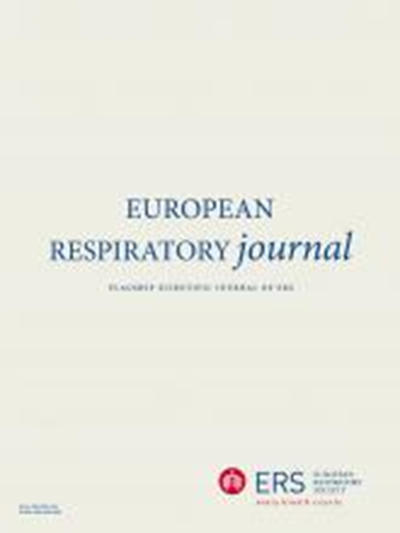口服中性粒细胞弹性酶抑制剂alvelestat治疗α -1抗胰蛋白酶缺乏症的两项随机对照2期研究。
IF 21
1区 医学
Q1 RESPIRATORY SYSTEM
引用次数: 0
摘要
背景:α -1抗胰蛋白酶缺乏症(AATD)是一种遗传性疾病,由于缺乏AAT丝氨酸抗蛋白酶,导致蛋白酶-抗蛋白酶失衡而导致肺气肿。每周静脉注射AAT治疗(增强)是唯一有效的治疗方法。Alvelestat是一种口服中性粒细胞弹性酶(NE)抑制剂,作为AATD治疗的新方法正在开发中。在这里,我们测试了alvelestat治疗严重AATD的安全性和机制有效性。方法我们进行了两项互补、双盲、随机、安慰剂对照、为期12周的试验,在AATD中纳入了两种剂量的阿韦司他。亚特兰大研究了每日两次120毫克,包括一部分也接受强化治疗的参与者;ASTRAEUS测试120毫克和240毫克,每天两次,没有增加。主要和次要终点是血液NE(假定的靶点)的变化及其在AATD中的活性(Aα-Val360和桥糖苷/异桥糖苷)以及安全性和耐受性。结果共纳入161名受试者(亚特兰大63名,阿斯特赖奥斯98名)。在两项研究中,两种剂量的血NE都被显著抑制,其中在240 mg BID剂量时效果最大(>90%的抑制)。120 mg对疾病活性生物标志物无影响,而240 mg剂量可显著降低Aα-Val360和氨基葡萄糖。最常见的不良反应是头痛,尤其是在240毫克的剂量下。没有检测到值得关注的安全信号。结论salvelestat在两种剂量下都能有效抑制NE及其活性,但与安慰剂相比,只有240 mg每日两次的剂量在疾病活性生物标志物上显示出相关的疗效,并且具有良好的安全性。这些发现支持将240mg每日两次的剂量推进临床终点研究。本文章由计算机程序翻译,如有差异,请以英文原文为准。
Two randomized controlled Phase 2 studies of the oral neutrophil elastase inhibitor alvelestat in alpha-1 antitrypsin deficiency.
BACKGROUND
Alpha-1 antitrypsin deficiency (AATD) is a genetic disorder that causes emphysema from lack of the AAT serpin anti-protease, leading to protease-anti-protease imbalance. Weekly intravenous AAT therapy (augmentation) is the only specific treatment available. Alvelestat is an oral inhibitor of neutrophil elastase (NE) in development as a novel approach to AATD therapy. Here, we tested the safety and mechanistic efficacy of alvelestat in severe AATD.
METHODS
We conducted two complementary, double-blind, randomized, placebo-controlled, 12-week trials, incorporating two doses of alvelestat in AATD. ATALANTa investigated 120 mg twice daily, including a subset of participants also receiving augmentation; ASTRAEUS tested 120 mg and 240 mg twice a day without augmentation. Primary and secondary endpoints were the change in blood NE (the putative target) and its activity in AATD (Aα-Val360 and desmosine/isodesmosine) as well as safety and tolerability.
RESULTS
We enrolled 161 participants (63 in ATALANTa and 98 in ASTRAEUS). Blood NE was significantly suppressed in both studies at both doses, with the greatest effect (>90% suppression) at the 240 mg BID dose. There was no effect of 120 mg on disease activity biomarkers, whilst the 240 mg dose demonstrated significant reduction Aα-Val360 and desmosine. The most common adverse event was headache, particularly at the 240 mg dose. No safety signals of concern were detected.
CONCLUSIONS
Alvelestat effectively suppressed NE and its activity at both doses, but only the 240 mg twice daily dose demonstrated relevant efficacy compared to placebo on disease activity biomarkers with a favourable safety profile. These findings support progression of the 240 mg twice daily dose into a clinical endpoint study.
求助全文
通过发布文献求助,成功后即可免费获取论文全文。
去求助
来源期刊

European Respiratory Journal
医学-呼吸系统
CiteScore
27.50
自引率
3.30%
发文量
345
审稿时长
2-4 weeks
期刊介绍:
The European Respiratory Journal (ERJ) is the flagship journal of the European Respiratory Society. It has a current impact factor of 24.9. The journal covers various aspects of adult and paediatric respiratory medicine, including cell biology, epidemiology, immunology, oncology, pathophysiology, imaging, occupational medicine, intensive care, sleep medicine, and thoracic surgery. In addition to original research material, the ERJ publishes editorial commentaries, reviews, short research letters, and correspondence to the editor. The articles are published continuously and collected into 12 monthly issues in two volumes per year.
 求助内容:
求助内容: 应助结果提醒方式:
应助结果提醒方式:


